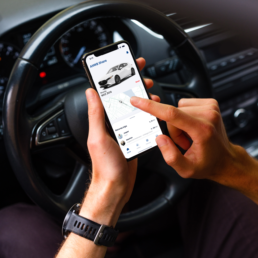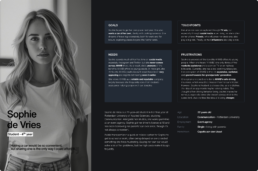ANWB Share
We have been given an exciting challenge: to make young people (ages 18-25) enthusiastic about ANWB. The core challenge is: “How can we engage, activate, and retain consumers aged 18 to 25 as members/customers in the field of mobility?” Our goal is to create a vibrant environment where young people feel at home and can fully benefit from everything ANWB has to offer.
So, buckle up—we’re embarking on an exciting journey to craft a new, refreshing ANWB experience tailored to a younger audience!
ClientANWB [schoolproject]ServicesUser experience design, user interface design, user researchYear2021
35%
Approximately 35% of students see a shared car as a good option, especially if it’s affordable, easy to use, and flexible to meet their needs.
Studies on student mobility often indicate that around 20-40% of students are open to or actively use car-sharing and similar shared mobility services when costs are low and access is easy.
For young people, ANWB is primarily associated with roadside assistance and insurance.
91%
91% of the target audience is unaware of the youth discount.
Young people lack awareness of ANWB’s services and offers, indicating a need for improved communication tailored to this group. Although ANWB is seen as a large and reliable company, it also carries a somewhat outdated image. For young people, ANWB is primarily associated with roadside assistance and insurance. Cost savings are a key factor for this demographic.
Research
During the research phase, we combined various methods and techniques to gain a clear understanding of young people's needs and preferences, helping us refine our concept. We began with desk research, gathering national statistics and background information on student housing and mobility. These data provided insights into the target audience’s living and travel behaviors, allowing us to set a clear focus for our project.
To define the core values and purpose of our concept, we used the Golden Circle method. This approach helped us articulate why our concept would be valuable for young people and how we could make it appealing. Next, we conducted interviews with students living in shared housing. These conversations provided valuable, direct feedback on their mobility needs and the challenges they face with existing transportation options, such as public transport and car sharing.
Based on these insights, we formulated a hypothesis for the car-sharing concept and presented it to a mentor and potential users for testing and validation. This resulted in a refined concept that better aligned with the expectations and needs of the target audience. By integrating these methods, we gained a strong understanding of what resonates with young people and how ANWB could effectively address these needs.
Concept and prototyping
We started with idea generation and co-creation, organizing team brainstorming sessions to explore various mobility concepts for student housing. Three initial concepts were presented, with the car-sharing option for student residences receiving the most positive feedback. Based on user and expert feedback, we chose to continue with this concept, where students could share a car to save costs and gain access to flexible mobility. These co-creation sessions allowed us to further develop and adapt the idea to better suit the needs of the target audience.
Next, we moved to the wireframing stage, creating initial sketches and flowcharts for the app. Each team member individually worked on screen designs for core functionalities, such as the home screen, planner, and group overview. These wireframes were then reviewed and refined into a cohesive design. We created high-fidelity screens in Figma, adding navigation tabs and a clear overview of available time slots to ensure usability.
The final result was a prototype of the app, enabling students to easily reserve a car and share costs within their housemates’ group. The app includes features such as a user-friendly planner, profile settings, and a system to track usage statistics. After rounds of feedback from design and target group experts, the app was further optimized to ensure an intuitive experience. This resulted in a concept that addresses both the mobility needs and budget concerns of students, providing ANWB with an innovative way to engage with young users.


